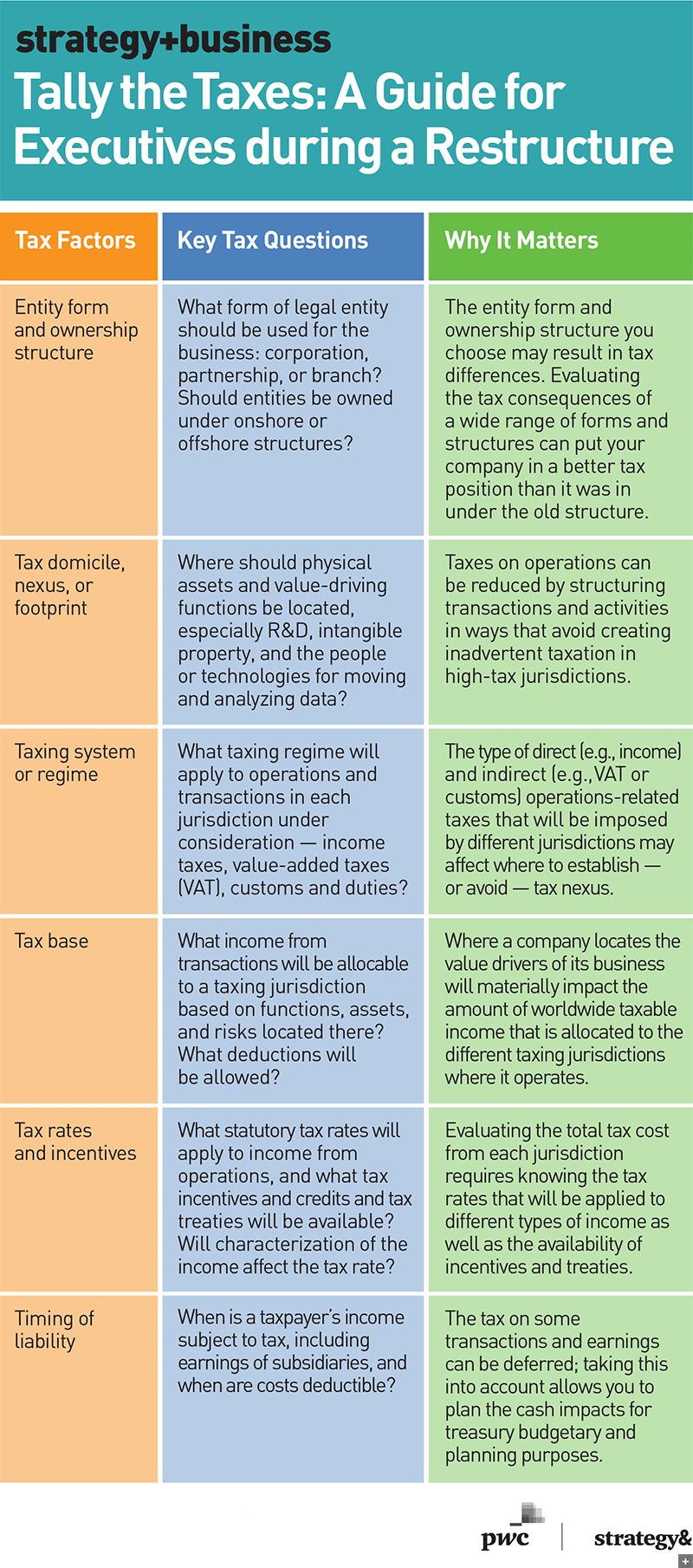The Tax-Savvy Company Restructuring
Most structural changes will have tax implications. Thoughtful planning can help leaders convert tax traps into enhanced reorganization returns.
A version of this article appeared in the Summer 2018 issue of strategy+business.
In late 2017, amid a barrage of public debate and media attention, U.S. President Donald Trump signed into law the most sweeping U.S. tax legislation in more than 30 years. The move sparked a phenomenon in which practically everyone was thinking, and talking, about taxes.
An attention-grabbing event such as this passage of the Tax Cuts and Jobs Act provides opportunities to bring an often overlooked but essential discipline to the forefront of the corporate leadership agenda: integrating tax considerations into business decisions. If there are two enduring certainties for companies, they are restructuring and taxes. And although restructuring, reorganizing, realigning — or whatever other term you assign it — is central to corporate life, taxes are often rendered an afterthought. And that can be a costly mistake.
Already, too many executives do not restructure their companies correctly. They choose to cut a percentage of costs across the board instead of focusing on their strengths. And even when executives do restructure in a way that’s smart, they overlook important tax implications. At best, doing so weakens the impact of a restructuring; at worst, it negates the impact altogether, leaving companies weaker than when they started.
How do you restructure your company most effectively? And how do you combine such efforts with right-minded tax strategies for optimum growth potential?
Restructuring the Right Way
Executives need to reorient their company or trim their cost structure for a good reason — for example, to deliver a new strategy, to respond to market disruptions, or to improve declining profits. Sometimes several of these reasons are present. Yet too many companies cut the wrong costs: They cut the good costs (the muscle) they need for future growth along with the bad costs (the fat); they cut costs across the board, mandating a certain percentage reduction in every area of the company; or they do not change the ways of working that led to the inefficient cost structure in the first place, all but ensuring those cost reductions will be temporary.
Even when executives do restructure their company in a way that’s smart, they overlook important tax implications.
Instead, companies need to restructure in a way that puts them on solid footing for future success, making them fit for growth. Fit for Growth* restructurings start with a clear focus on a company’s strategy and future growth. Executives clarify what few differentiating capabilities lie at the heart of their competitive advantage and must be strengthened; next, they align their cost structures with those capabilities, recognizing that not all costs are bad. Then they organize for lasting growth.
Factoring Taxes into the Plan
Restructuring the right way is hard enough. But even when executives get it right, they too often miss another crucial element: incorporating the tax consequences of wide-ranging restructuring decisions.
Whether you’re switching locations, adjusting your supply chain, or making almost any other structural change, it has implications for the amount of tax your company will pay. Still, although executives intuitively know that taxes are important to the company’s ultimate profitability (and income available to shareholders), they don’t often evaluate these costs as part of the restructuring effort. Rather, they treat taxes as a cost of compliance, after the major decisions are made. Consequently, they are likely either to create tax inefficiencies or to miss opportunities to put their companies in a better tax position than they had in under the old structure.
Two examples we encountered in our work perfectly illustrate this problem.
One multinational company recently consolidated several global IT centers into one shared-services center in the United States. But it turned out that the savings generated from reducing labor costs were consumed by the increase in U.S. taxable income. If the company had evaluated the tax implications of the consolidation, it could have structured the change in a way that was more strategic and would not have negated the cost savings.
Another company sold a manufacturing facility to reduce its investment in non-value-added capabilities. To keep its supply chain intact, however, the company had the same legal entity that sold the plant enter into a contract with the new owner to continue making its products. If leaders had evaluated the transformation from a tax perspective, they would have structured the arrangement in a better way. If a different legal entity within the company’s multinational group located in a different tax jurisdiction had contracted with the new owner, the company’s tax obligation on its profits could have been reduced by more than 15 percentage points.
Why is such a seemingly straightforward concept so often missed? The answer is maddeningly simple: The people thinking about restructuring issues are often unconnected to the experts who can properly evaluate tax considerations in today’s complex tax environment. The first group focuses on their primary problem of how to restructure the company or a part of the company. Taxes are someone else’s problem after the fact, they assume, and will be optimized within the constraints of the newly restructured company.
The solution, then, is fairly obvious: Ensure that executives and middle managers in a company have a basic understanding of when tax considerations may come into play in a restructuring. This way, even if they cannot optimize for taxes themselves, they at least know to reach out for the tax advice they need early enough to avoid wasted time (at best) or huge lost profits.
Tax laws change in different countries in any given year, but if a restructuring is currently moving ahead, executives already have a multitude of geopolitically driven considerations to think through. In addition to the major tax reform in the U.S., there are other factors to consider, including the state of the Trans-Pacific Partnership after the U.S. withdrawal and the fallout from Brexit. Additionally, changes are possible in other trade agreements, including NAFTA, that would have significant implications for import taxes. In the European Union, efforts are under way to boost tax transparency and close loopholes that allow tax avoidance. And more than 100 countries are involved in the BEPS project (the OECD’s Base Erosion and Profit Shifting effort), an international framework intended to combat tax avoidance. It’s a complex picture, but there’s benefit to understanding how management decisions can make the difference in what companies pay.
Taking a Closer Look
Leaders should proactively consider tax implications if the restructuring includes changes to the business footprint, the legal entity structure, or the flow of goods across taxing jurisdictions (see “Tally the Taxes: A Guide for Executives during a Restructure”). In particular, any changes to where the operations are located or where goods are procured could have significant tax implications. What follows is a closer look at a few common ways in which companies getting fit for growth create sizable tax implications.
Optimize the company’s geographic footprint. A company’s footprint is made up of all the physical locations where it has administrative offices, shared services, R&D centers, service points, manufacturing plants, and distribution centers. When you shut down a distribution center or open a new manufacturing plant in a different country, for example, you’re changing your company’s physical footprint. Reevaluating this footprint can reduce operating costs by as much as 20 percent over 12 to 24 months. For instance, creating shared services and moving work to a new center in a different state in the U.S. or to a new country could change the taxation as well as entitle a company to incentives from state or national governments. Accordingly, every geographic change requires an after-tax evaluation of the costs to operate and relocate so you can know exactly how you’d fare in different locations.
Redesign the operating model to address where critical work gets done in the organization and to reorganize resources . Similar to the footprint considerations, changing the company’s operating model, organization structure, or legal entity structure could have tax implications. For example, companies often have shared services or global business services that can deliver support services (such as IT, finance, and HR) more efficiently and effectively. Many times, these service organizations are located in countries or states different from those of the organization’s headquarters. Any redesign, as a result of operating model changes, could have tax implications. In fact, any change in how and where a company drives value into its value chain through activities, decision making, and risk taking can alter the distribution of the company’s tax base across taxing jurisdictions, substantially affecting total tax costs.
For example, if a company decides to consolidate and relocate a valuable procurement staff and function to a single central location, it is changing where critical work is done, resulting in a shift of profits from the previous locations to the new location — likely resulting in a change to total taxes. Or if a company decides to start a new profitable manufacturing business in Mexico, it may make sense to hire employees in a different legal entity to create better tax efficiency under Mexico’s profit-sharing rules.
Shrink non-labor expenses through strategic supply management. A strategic look at supply management can reduce total external spending by 10 to 15 percent, often within nine months. Taxes could change depending on the country where raw materials originate, whether components are bought as separate parts or as full assemblies, or whether there are tax incentives or exemptions. When looking at taxes this way, the biggest spending categories should be checked for tax optimization.
One company we’ve worked with, for example, created a new sourcing plan after a large merger. The sourcing group didn’t work with the tax function, which resulted in the plan generating a suboptimal recommendation on an after-tax basis thanks to indirect value-added taxes (VAT) and customs/duties costs that weren’t considered.
A Final Caution
An old adage among corporate tax executives goes, “Don’t let the tax tail wag the operations dog.” Up until now, we’ve been discussing the essential need for a company to take tax considerations into account when it decides to execute a restructuring. In rare instances, however, changes to tax laws can be so material in their impact on a company’s bottom line that the company needs to realign how and where it is doing business. Just as a company might respond to a sudden increase in labor or energy costs, it might need to respond to major changes in tax laws.
The U.S.’s Tax Cuts and Jobs Act may just be one of those instances. Under the act, U.S. federal corporate tax rates are reduced from 35 percent to 21 percent — a massive cut by tax-law standards. Additionally, some of its provisions reduce benefits for U.S. multinationals that own certain assets in low-tax foreign jurisdictions. As a result, multinational corporations with a global footprint need to reassess whether they are still operating — on an after-tax return basis — in the best locations after taking into account all the cost factors that drive their footprint decisions, including labor, facilities, freight, and tax costs, as adjusted for the new laws.
Therefore, although companies might not be looking to restructure for operations reasons, changes in the cost of doing business attributable to taxes can alter the ROI on their operating assets and serve as a call to action.
Taking a Fit for Growth approach can change the way companies think about how tax can be a partner with strategy. With this kind of thinking as the norm, the tax function can work with you to protect the new cost structure you’re banking on.
Author profiles:
- Deniz Caglar is a leading practitioner in strategic cost transformation for Strategy&, PwC’s strategy consulting business. Based in Chicago, he is a principal with PwC US. He specializes in organization and cost transformations in financial services, retail, and consumer packaged goods. He is the coauthor, with Vinay Couto and John Plansky, of Fit for Growth: Strategic Cost Cutting, Restructuring, and Renewal (Wiley, 2017).
- John Ranke is a partner with PwC US in the international tax services practice. Currently a member of PwC’s national tax group, he specializes in guiding clients through large-scale strategic restructurings that deliver long-term tax efficiency through the implementation of business alignment, foreign tax reduction, and cash redeployment structures.
- *Fit for Growth is a registered service mark of PwC Strategy& LLC in the United States.






